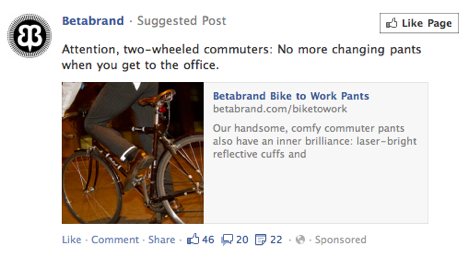I’m always shocked at how often companies assume the existence of a really motivated and patient customer.
They assume that customers coming to their Website from a mass media ad will diligently search through their drop navigation system, looking for the stuff that’s relevant to the ad — rather than, you know, placing a nice fat call-out directly on the home page. Or even directing people to a campaign-specific landing page.
Or they assume that advertising audience is going to pay minute attention to the entire ad so that they can bury the “why should I care information 15 seconds in or something.
But customers almost never do this. If they can’t find it on your site within a click or two, they’re gone. If the ad isn’t fabulously entertaining or doesn’t move the needle on the “who gives flip” meter, people will tune out.
And the same is doubly true for people on Facebook. This is an audience that has already chosen to immerse themselves in the distraction that is online community, gossip, and news. They’re not going to break away from that to diligently hunt down your interesting or relevant content.
Here’s what I mean:
Now, if you bothered to click through on this ad — and not many would bother, but if you did – then you’d find some interesting videos there, that you might even care to watch.
So why the heck didn’t Shell pick out some of the most interesting videos and advertise them directly, with a really cool video still shot to grab your eye and some compelling ad copy to get you intrigued enough to click to watch the actual video? They’d get a whole heck of a lot more engagement, right?
But they’re not doing that because they’re assuming a much more motivated audience than really exists. Or they assume that they’re little campaign carries a lot more relevance to the average Facebooker than it does.
This, of course, is a rather blatant example, but this same problem exists at lower levels for most Facebook ads. Take this Betabrand ad as an example:
If you’re not familiar with Betabrand, they’re the company that makes dress pant sweatpants — dress pants made from sweat pant fleece — and corporate pinstriped hoodies, and disco-ball pants and that kind of stuff.
In other words, what most people think of as really cool novelty items. So “bike to work pants” fits right in. Or does it?
The thing about bike to work pants is that, after you’ve biked to work, you then have to work all day in those same pants. So if they’re built like a typical novelty item, they’re not such a good idea, right?
So… why not advertise a user review of the pants, talking about how they’re great all around pants that also, just happen to be optimized for bicycling and bike safety.
Sure, consumers might click through just to see more about the bike to work pants. But many won’t bother because they’ve already assumed the pants are a novelty item, and not built that well and won’t look that great as regular pants.
And yet Betabrand just assumes the prospective customer is motivated enough to click through to the Website or their Fan Page and peruse the content to try to find out.
The fact is, though, that user-generated reviews are a great way to boost response in general, and preemptively addressing key buyer concerns is almost always guaranteed to boost ad response. So BetaBrand is missing out on two sure-fire methods of increasing their ad’s effectiveness.
But this post isn’t really about Shell or Betabrands or their advertising. It’s about you and your advertising. So ask yourself:
- Am I assuming the audience is more motivated than it is?
- Am I holding back on the “why you should care” info until it’s too late.
- Am I assuming that I can explain the good stuff post-click?
- Does my ad immediately pique interest and curiosity?
- Could I leverage user-generated reviews in my ad?
- What’s the major buyer concern for my product or service, and how might I preemptively address it in my ad?
If you want higher click-through and conversion rates from your Facebook Ads, don’t blame the audience for not caring or not engaging — blame the ads, and then commit to creating and testing better ones.




